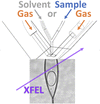issue contents
November 2023 issue

scientific commentaries
CHEMISTRY | CRYSTENG
This commentary discusses the design of stimuli-responsive materials, specifically, light-responsive dithienylethene-based compounds. Recent progress in predicting photoactivity using a combination of theory and crystal structure landscape experiments is highlighted.
PHYSICS | FELS
In this commentary, we explore the pioneering implementation of 3D-printed thin liquid sheet devices for advanced X-ray scattering and spectroscopy experiments at high-repetition rate XFELs.
topical reviews
PHYSICS | FELS
Photosystem II is the enzyme responsible for generating nearly all the oxygen in the atmosphere. Room-temperature time-resolved crystallography and spectroscopy measurements at X-ray free-electron lasers help to elucidate the sequence of events in the water oxidation reaction of photosystem II leading to the formation of dioxygen from two molecules of water.
NEUTRON | SYNCHROTRON
Diffuse X-ray scattering is used to characterize the time dependence of the liquid phase emerging from femtosecond laser-induced melting of polycrystalline gold thin films using an XFEL. Its structure factor and partial pair distribution function confirm the liquid origin of the diffuse scattering. The liquid fraction increases with a characteristic rise-time of 13 ps.
research papers
PHYSICS | FELS
In this study, liquid sheet jet sample injection was demonstrated at the EuXFEL SPB/SFX beamline. A 3D-printed gas-accelerated nozzle design was used to produce sheet jet thicknesses below 100 nm resulting in a significantly more stable scattering signal compared with a conventional cylindrical liquid jet. The radiation-induced explosion was found to not perturb data collection for repetition rates approaching megahertz. These results demonstrate the great potential of sheet jets for high-repetition-rate liquid sample injection and their adoption for both scattering and spectroscopy experiments.
CHEMISTRY | CRYSTENG
Download citation


Download citation


Five coordination polymers were obtained based on an azo multifunctional aromatic ligand. The movement and collision behaviors of components are greatly affected by the magnetic field assisted method, which could have a subsequent impact on their structures with different space groups.
PHYSICS | FELS
The micro-structured polymer chip is a new polymer fixed-target support for serial crystallography experiments at synchrotrons and X-ray free-electron lasers; these micro-structured supports contain a precise array of apertures that allow rapid aperture-alignment-based data-collection strategies. Here, the chip-fabrication process is presented and discussed, as well as an analysis of ideal crystal-loading parameters and data quality.
CHEMISTRY | CRYSTENG
Download citation


Download citation


The crystal structure landscape of (Z)-1,2-bis[2-methyl-5-(pyridin-4-yl)thiophen-3-yl]-1,2-diphenylethene (DTE) was determined using a combination of computational and experimental molecular geometries. A novel D–D analysis was developed which provides a rapid, effective and intuitive means of visualizing the crystal landscape and assessing the conformer type present in and photoactivity of the resulting crystalline solids.
PHYSICS | FELS
Bonding orbital dynamics in ultrafast melting have been directly observed using femtosecond time-resolved resonant X-ray scattering at the Pohang Accelerator Laboratory X-ray Free-Electron Laser, and smoking-gun evidence on direct linkage between bonding orbitals and lattice stability unifying thermal-to-nonthermal reactions to explicate photo-induced phase transitions is provided.
PHYSICS | FELS
A simple, robust and computationally inexpensive method of generating statistical representations of X-ray free-electron laser (XFEL) radiation is presented.
CHEMISTRY | CRYSTENG
Download citation


Download citation


Advances in X-ray hardware and software have revolutionized crystallography: now crystal structures can be routinely solved first, with publication-quality datasets collected second. This same approach now allows multi-grain crystallography to be completed in the laboratory with Cu Kα X-rays.
NEUTRON | SYNCHROTRON
The first demonstration of 2 kHz time-resolved serial crystallography data acquisition at a fourth-generation synchrotron, using the JUNGFRAU 4M pixel detector.
BIOLOGY | MEDICINE
Enolase catalyzes the reversible conversion of 2-phosphoglycerate to phosphoenolpyruvate. Structural snapshots of Mycobacterium tuberculosis enolase provide critical insights into the mechanism of conversion of phosphoenolpyruvate to 2-phosphoglycerate.
EMDB references: enolase from M. tuberculosis, EMD-30988; PEP bound enolase from M. tuberculosis, EMD-30989
PDB references: M. tuberculosis enolase, 7ckp; M. tubeculosis enolase in complex with 2-phosphoglycerate, 7cll; M. tuberculosis enolase in complex with alternate 2-phosphoglycerate, 7clk; M. tuberculosis enolase mutant S42A, 6l7d; M. tuberculosis enolase mutant E163A, 7dlr; M. tuberculosis enolase mutant E204A complex with phosphoenolpyruvate, 7e4f; cryoEM structure of enolase from M. tuberculosis, 7e4x; cryoEM structure of PEP bound enolase from M. tuberculosis, 7e51
MATERIALS | COMPUTATION
A new interaction energy model for molecular dimers, CE-1p, accurately calculates intermolecular interactions in molecular crystals. Improved treatment of dispersion and polarization helps it outperform existing models with accuracy comparable to advanced DFT methods with only a single fitted parameter.
CHEMISTRY | CRYSTENG
Download citation


Download citation


We present δ-P4, a new polymorph of white phosphorus. It crystallizes as a sixfold twin with the cell dimensions a = 18.302 (2), b = 18.302 (2), c = 36.441 (3) Å in the space group P212121 with 29 P4 tetrahedra in the asymmetric unit. Although their arrangement resembles the structure of α-Mn as proposed for α-P4, δ-P4 differs from α-P4.


 journal menu
journal menu




 access
access




























